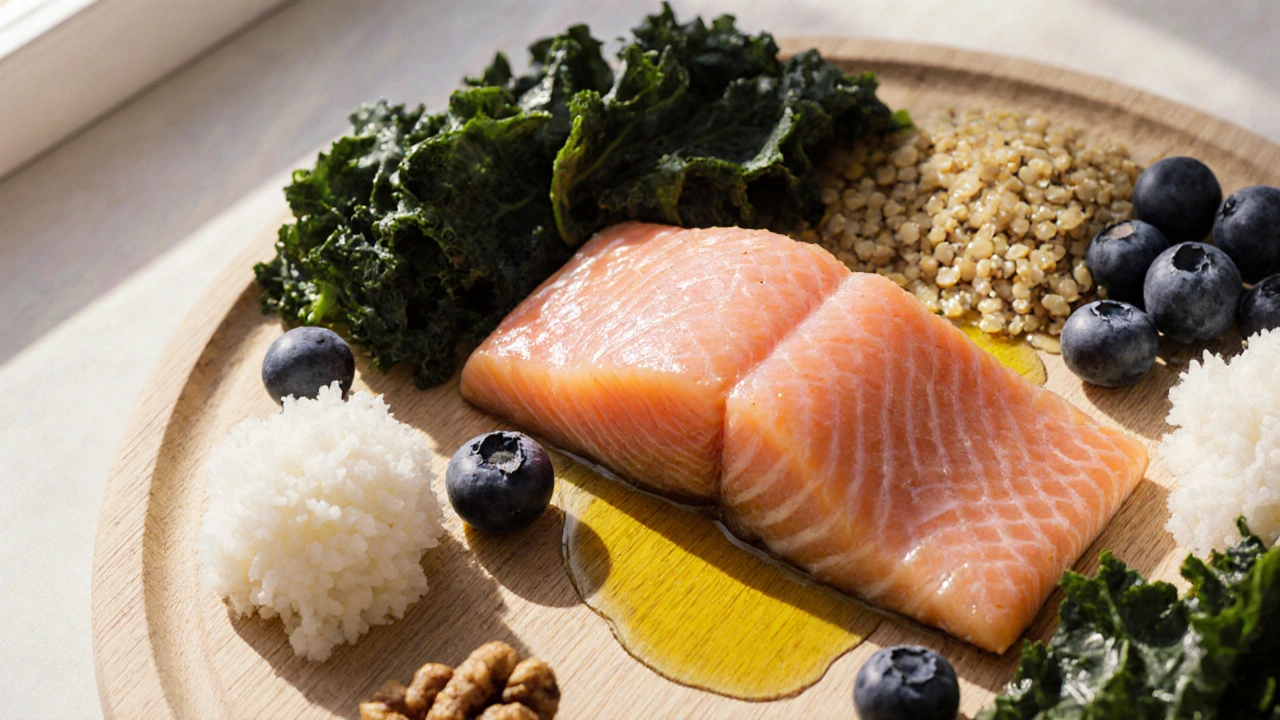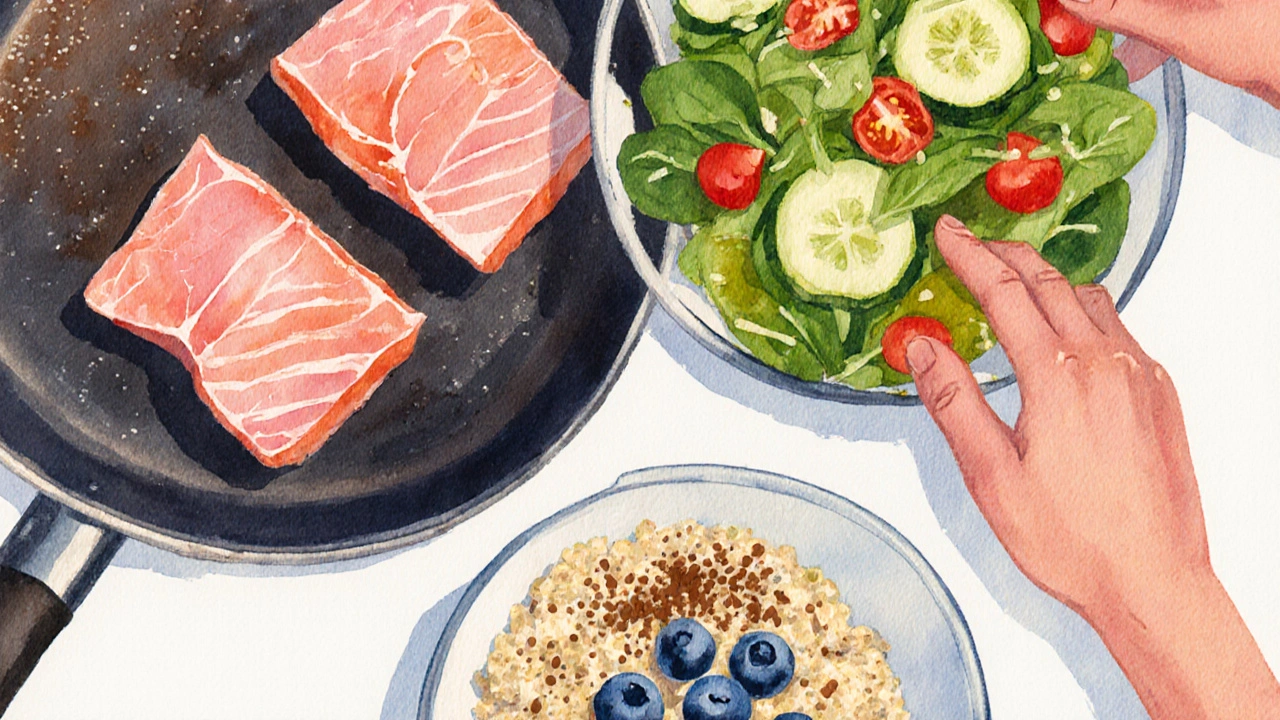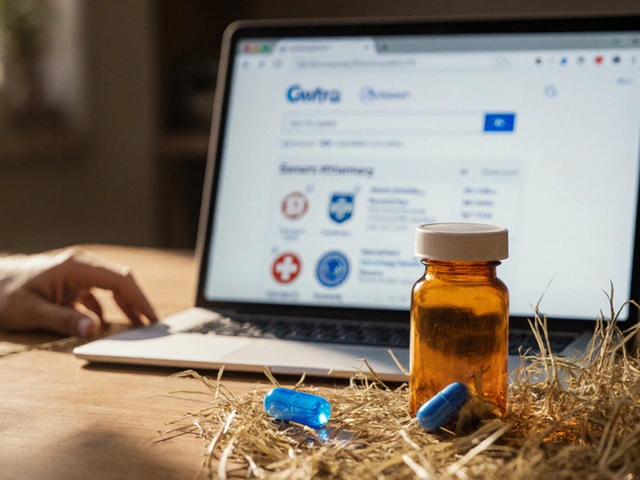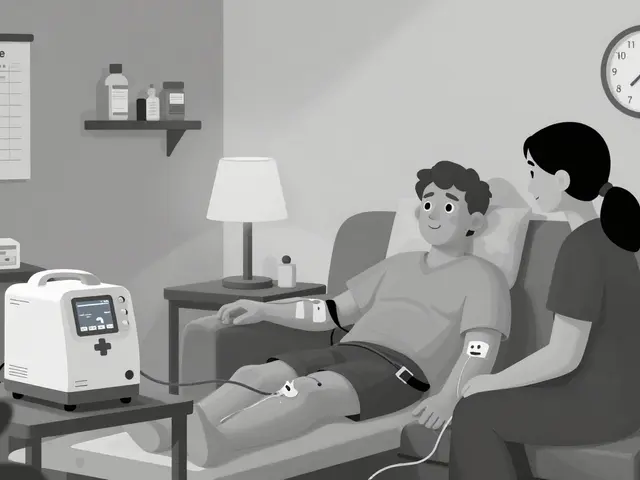
Psoriasis Diet Checker
Foods to Eat
These foods support skin health and reduce inflammation
Foods to Avoid
These foods may trigger flare-ups in some individuals
Your Diet Analysis
Struggling with flare‑ups despite creams and meds? You might be overlooking a simple, everyday tool: what you put on your plate. The psoriasis diet isn’t a magic cure, but the right choices can calm inflammation, support skin renewal, and reduce the frequency of eruptions.
Quick Takeaways
- Focus on anti‑inflammatory foods rich in omega‑3s, antioxidants, and fiber.
- Avoid gluten, dairy, processed sugars, and excess red meat.
- Vitamin D, probiotics, and a Mediterranean‑style eating pattern are especially helpful.
- Track symptoms alongside meals to spot personal triggers.
- Combine diet changes with stress‑reduction and adequate sleep for best results.
Understanding Psoriasis and Why Food Matters
Psoriasis is an autoimmune condition that speeds up skin cell turnover, leading to thick, silvery patches. While genetics set the stage, lifestyle factors-especially diet-play a starring role in how often the immune system decides to overreact.
Research from the National Psoriasis Foundation (2023) shows that people who adopt an anti‑inflammatory eating pattern report up to 30% fewer severe flares. The link lies in inflammation: the more you fuel chronic inflammation with certain foods, the more likely the skin will react.
Inflammation is the body’s immune response that, when prolonged, can damage tissues and trigger conditions like psoriasis. Your diet can either calm this fire or fan the flames.
Core Principles of a Psoriasis‑Friendly Diet
- Emphasize anti‑inflammatory nutrients. Think omega‑3 fatty acids, antioxidants, and soluble fiber.
- Limit known triggers. Gluten, dairy, added sugars, and excess saturated fat have been linked to flare‑ups.
- Support gut health. A balanced microbiome can modulate immune responses.
- Stay consistent. Sudden, restrictive diets often backfire; gradual changes work best.

Foods to Eat: What Fuels Clearer Skin
The following groups have the strongest evidence for soothing psoriasis symptoms.
- Fatty fish (salmon, mackerel, sardines) - packed with Omega-3 fatty acids are essential fats that reduce inflammatory cytokines and may decrease plaque thickness. Aim for two servings per week.
- Berries (blueberries, strawberries, raspberries) - high in anthocyanins, powerful Antioxidants that neutralize free radicals and lessen skin redness.
- Leafy greens (spinach, kale, Swiss chard) - loaded with vitamin K, magnesium, and fiber that support skin barrier integrity.
- Olive oil - a staple of the Mediterranean diet, it provides monounsaturated fats and polyphenols that keep inflammation in check.
- Whole grains (quinoa, brown rice, oats) - supply soluble fiber, which feeds good gut bacteria and helps regulate immune responses.
- Legumes (lentils, chickpeas, black beans) - rich in protein and fiber, plus plant‑based iron that avoids the excess saturated fats of red meat.
- Nuts & seeds (walnuts, flaxseeds, chia) - another omega‑3 source plus zinc, essential for skin healing.
- VitaminD‑rich foods - fortified plant milks, mushrooms exposed to UV light, and eggs. Low vitaminD levels correlate with more severe psoriasis, so boosting intake can be helpful.
Foods to Avoid: Common Triggers to Keep at Bay
While individual tolerances vary, the following items have the most consistent reports of aggravating psoriasis.
- Gluten - found in wheat, barley, rye. Some patients experience a noticeable improvement after a gluten‑free trial, especially if they have a concurrent celiac sensitivity.
- Dairy - milk, cheese, butter. Case studies suggest dairy can increase skin scaling in a subset of people due to its saturated fat content and potential hormonal effects.
- Processed sugars - sodas, candy, pastries. High glycemic loads spike insulin, which can amplify inflammatory pathways.
- Red and processed meats - beef, pork, sausages. They contain arachidonic acid, a precursor to pro‑inflammatory eicosanoids.
- Alcohol - especially beer, which combines gluten and alcohol, both known triggers.
- Nightshades (tomatoes, peppers, eggplant) - some anecdotal reports link them to flare‑ups, though evidence is mixed. Consider a short elimination if you suspect sensitivity.
Sample One‑Day Meal Plan
- Breakfast: Overnight oats made with rolled oats, almond milk, chia seeds, and a handful of blueberries. Sprinkle with cinnamon for extra anti‑oxidant power.
- Mid‑morning snack: A small handful of walnuts and an apple.
- Lunch: Quinoa salad with mixed greens, roasted salmon, cherry tomatoes, cucumber, and a drizzle of olive‑oil‑lemon dressing.
- Afternoon snack: Carrot sticks with hummus (garlic‑free if nightshades are an issue).
- Dinner: Stir‑fried tofu, broccoli, and snap peas in ginger‑turmeric sauce, served over brown rice.
- Evening treat: A cup of probiotic‑rich kefir (dairy‑free) or a small bowl of mixed berries.
This plan hits omega‑3s, antioxidants, fiber, and vitaminD while staying free of gluten, dairy, and added sugars.

Supplements & Lifestyle Enhancements
Even with a solid diet, a few targeted supplements can fill gaps.
- Fish oil capsules - 1,000mg EPA/DHA daily for those who don’t eat fish regularly.
- VitaminD3 - 1,000-2,000IU if blood levels are low (check with your GP).
- Probiotics - look for strains like Lactobacillusrhamnosus and Bifidobacteriumlongum, which have shown modest skin benefits.
- Curcumin - 500mg with black pepper extract can further dampen inflammation.
Combine these with stress‑management techniques-meditation, yoga, or low‑impact exercise. Studies indicate that cortisol spikes can trigger flare‑ups, so a calm mind supports the diet’s work.
Tracking Progress and Avoiding Common Pitfalls
Switching foods feels overwhelming if you don’t see quick results. Here’s a simple tracking method:
- Start a food‑symptom journal for two weeks. Note every meal, portion size, and any skin changes.
- Identify patterns. If psoriasis worsens after a specific food, consider an elimination period of 2‑4 weeks.
- Re‑introduce foods one at a time, watching for delayed reactions (24‑48hours).
- Celebrate small wins-fewer itching episodes, smoother patches, or reduced need for topical steroids.
Common mistakes include going ultra‑low‑calorie (which can stress the body), cutting out entire food groups without replacement, and expecting immediate skin clearance. Patience pays off; most people notice measurable improvement after 8-12 weeks of consistent eating.
FAQs
Can a psoriasis diet cure the condition?
No. Diet can dramatically reduce flare‑ups and improve skin texture, but it’s not a substitute for medical treatment. Think of it as a powerful supporting tool.
How long before I see results?
Most people notice less itching and smaller plaques after 4-6 weeks, with more pronounced changes by 3 months. Consistency is key.
Do I need to eliminate gluten completely?
If you have a confirmed gluten sensitivity or celiac disease, strict avoidance is advisable. Otherwise, a 30‑day trial can reveal whether it’s a personal trigger.
Is dairy always bad for psoriasis?
Not universally. Full‑fat dairy can worsen inflammation for some, while low‑fat fermented options like kefir may help gut health. Test your tolerance.
What role does weight play?
Higher body‑fat percentages are linked to increased inflammatory markers, which can intensify psoriasis. Maintaining a healthy weight often leads to milder symptoms.
Next Steps
Start small: pick one “eat” group (like fatty fish) and one “avoid” group (like processed sugar) and incorporate the change for two weeks. Log your skin’s response, then add another habit. If you’re unsure about nutrient gaps, a quick chat with a dietitian can personalize the plan.
Remember, the Psoriasis Diet is a set of eating habits focused on reducing inflammation and supporting skin health. With the right foods, supplements, and a bit of tracking, you’ll give your immune system a better chance to stay calm and let your skin breathe.
Franklin Romanowski
I've been there-trying one diet after another and feeling like nothing sticks. The idea that food can calm inflammation feels both hopeful and a bit overwhelming at first. What helped me was focusing on a single change, like adding a serving of salmon twice a week, and watching the itch level off over a few weeks. It’s not a miracle cure, but those small wins add up and make the whole process feel doable.
Brett Coombs
All this “diet” hype is just a way for big pharma to sell more pills, keep us buying supplements instead of real meds.
John Hoffmann
The article correctly identifies omega‑3 fatty acids as anti‑inflammatory agents, yet it omits the significance of the EPA/DHA ratio in achieving therapeutic effects. Moreover, it would benefit readers to know that whole grains should be low‑glycemic, such as oats, rather than simply “brown rice.” Lastly, while the avoidance list mentions nightshades, recent studies suggest the evidence is anecdotal at best; a more nuanced discussion is warranted. In practice, patients often respond better when the diet is personalized rather than universally prescribed.
Shane matthews
I like the simple list no fluff just foods that actually help . The avoid section is spot on for me .
Rushikesh Mhetre
Whoa! This guide is a game‑changer!!! 🌟 Start your day with oats and berries, feel the energy surge, then hit the gym and end with a salmon dinner – boom, inflammation goes down!!! Remember, consistency is the secret sauce; even the tiniest tweak, like swapping butter for olive oil, packs a punch!!! Keep tracking, stay motivated, and watch your skin thank you!!!
Sharath Babu Srinivas
Looks like you’ve got a healthy dose of skepticism 🤔 – and that’s fine! While supplements can be over‑hyped, there’s solid data showing fish oil EPA/DHA can reduce cytokine levels in psoriasis patients. 🎣 So maybe it’s not a grand conspiracy, just a mix of good science and smart marketing.
Halid A.
Indeed, the EPA/DHA ratio is a critical factor that many guidelines overlook. Incorporating a precise measurement of this ratio could enhance the therapeutic value of dietary recommendations. Your emphasis on personalized nutrition aligns with current clinical best practices.
Brandon Burt
Reading through this guide, I can’t help but notice how many of the recommendations echo what I’ve seen in countless forums, health blogs, and even the occasional peer‑reviewed article, which, to be honest, makes me wonder about the originality of the content, but also reassures me that the suggestions are not pulled out of thin air; the emphasis on omega‑3 rich fish, for instance, is something I’ve been preaching for years, because the scientific literature is practically screaming about its anti‑inflammatory properties, and yet many people still ignore it, probably due to the cost or taste preferences, which is why I always suggest canned sardines as a budget‑friendly alternative, and let’s not forget the role of antioxidants found in berries, which not only combat oxidative stress but also improve overall skin elasticity, a point often missed by superficial articles that focus solely on flare‑up reduction; the guide also wisely advises limiting processed sugars, which is a major culprit in driving insulin spikes that can exacerbate systemic inflammation, a fact that is well‑established yet somehow remains under‑appreciated by the general public, especially when sugary foods are so deeply entrenched in our cultural rituals; moving on, the suggestion to avoid gluten and dairy may be beneficial for those with sensitivities, but it’s essential to recognize that blanket exclusions can lead to nutritional deficiencies if not carefully managed, so supplementation with calcium and vitamin D becomes crucial, particularly for individuals who cannot tolerate fortified plant milks; furthermore, while the article mentions probiotics, it would have been even more helpful to specify strains such as Lactobacillus rhamnosus GG, which have shown modest efficacy in modulating the gut‑skin axis, a concept that is still emerging but holds promise; finally, the holistic approach that couples diet with stress management, adequate sleep, and regular low‑impact exercise rounds out a comprehensive plan, because we all know that psoriasis is a multifactorial disease, and tackling it from a single angle is rarely sufficient, so this guide, despite its minor gaps, offers a solid, practical roadmap for anyone willing to commit to gradual, sustainable lifestyle changes.
Gloria Reyes Najera
Obviously I knew all this before anyone even posted it
Gauri Omar
Wow, you just dumped a whole textbook into a Reddit comment-talk about overkill! But hey, if you love sounding like a walking medical journal, go for it. Most of us just want a quick tip, not a 20‑minute lecture.
Willy garcia
Small changes add up fast.
zaza oglu
🌈 Dive into the rainbow of wholesome foods-think glittering salmon, sapphire berries, emerald greens, and golden olive oil-because your skin deserves a festival, not a famine, and every vibrant bite is a step toward calm, radiant confidence! 🌟






Write a comment